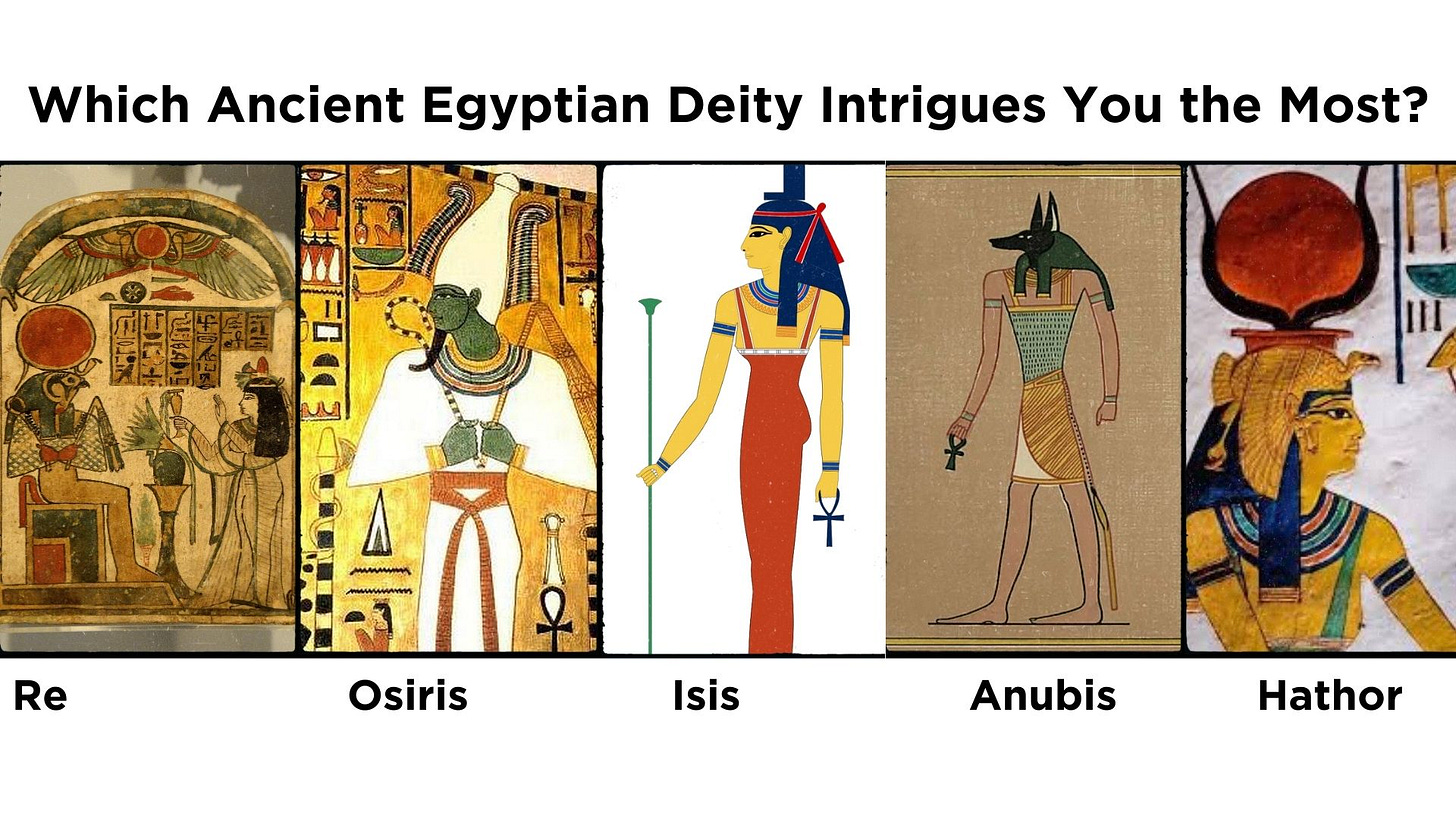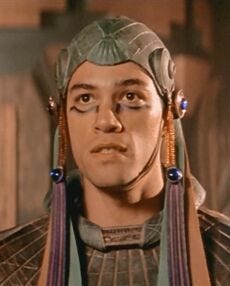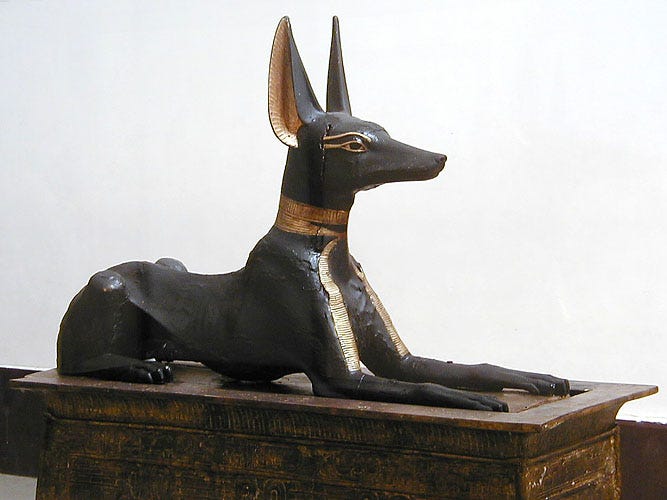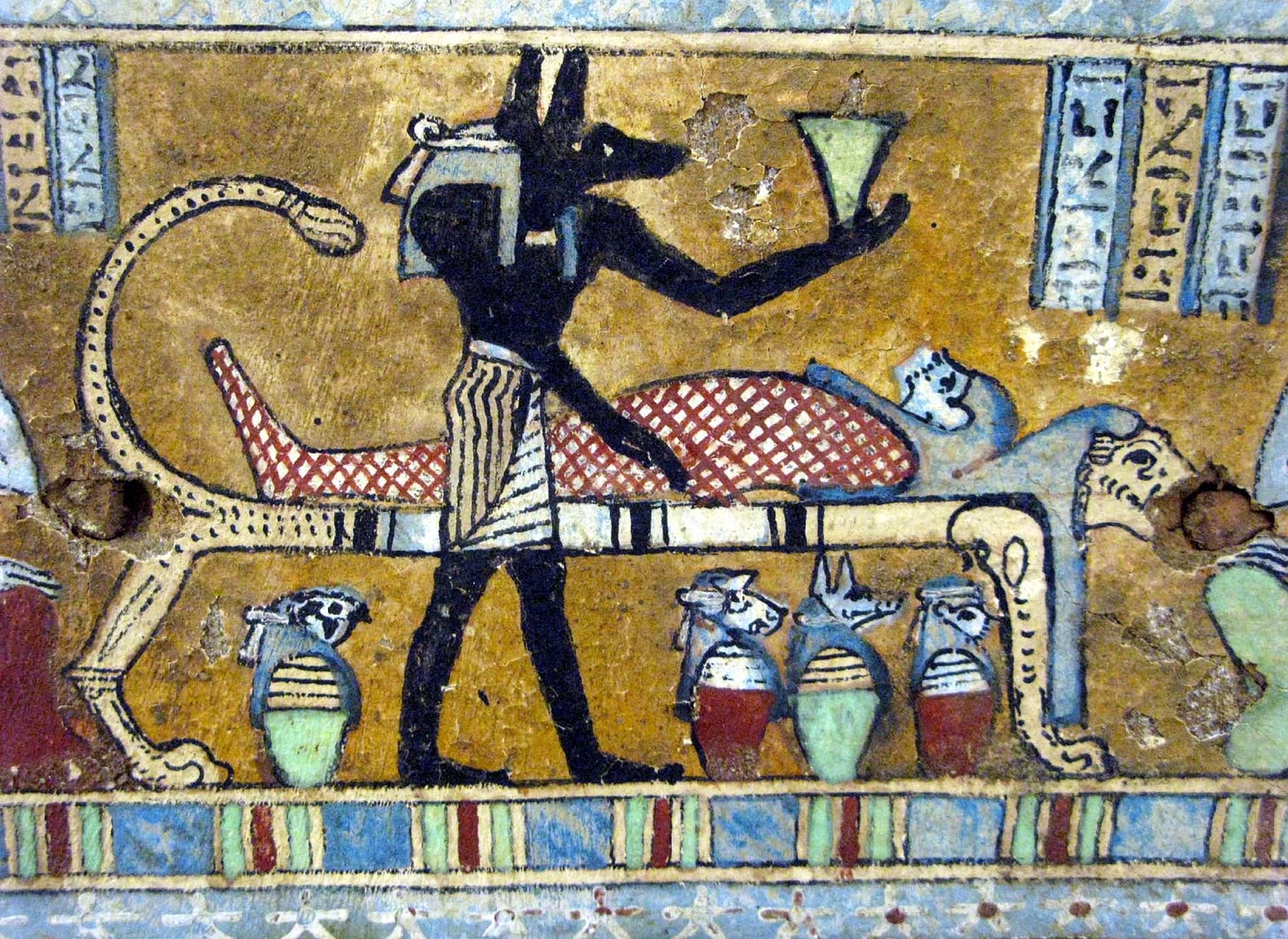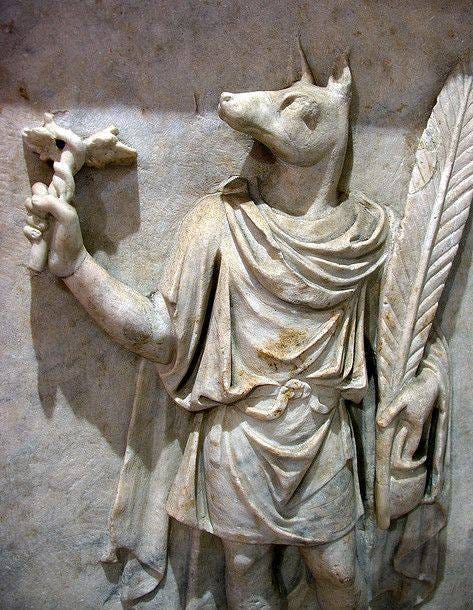Anubis: The most intriguing deity poll result
Guardian of Cemetery, Companion to Osiris and God of Embalming
In response to my recent poll.
Anubis, the ancient Egyptian god of mummification and the afterlife is one of the most iconic figures in Egyptian mythology. He is easily recognised as either a black (canine) dog or a man with the death of a black dog. Known as "Inpu" in ancient Egyptian language, Anubis was a complex deity associated with death, embalming, and the protection of the deceased. His role evolved throughout Egyptian history, reflecting changing beliefs about life, death, and the soul's journey to the afterlife.
In modern times, Anubis has transcended his ancient Egyptian origins to become a prominent figure in popular culture, appearing in movies, television, video games, and literature. In films like The Mummy Returns (2001) and shows like Stargate SG-1, Anubis is often depicted as a fearsome god with supernatural powers, blending elements of his ancient persona with the allure of mystery and terror. These portrayals frequently focus on his association with death and the afterlife, adding a mystical edge that aligns well with Hollywood's fascination with Egyptian mythology.
Anubis has also become a popular figure in modern fine art and body art, especially tattoos, where he is often chosen for his association with death, protection, and transformation. Many people find his role as a guide to the afterlife and protector of souls meaningful, and these qualities have made him a symbol of spiritual guardianship. In tattoos, Anubis is often portrayed in detailed, dark, and stylised designs that capture his essence as fierce and protective. This imagery resonates with individuals who view him as a figure of resilience, mystery, and reverence for the cycle of life and death.
Anubis (Stargate).
In video games, Anubis has become a staple character in titles such as Assassin's Creed Origins, SMITE, and Realm of the Mad God, where he often appears as a powerful warrior, protector, or adversary. His image aligns with popular themes in gaming—death, the supernatural, and combat—which makes him an ideal character for players seeking power or symbolic protection. Games often reimagine Anubis as a dynamic and formidable figure, embodying his ancient roles while adding a modern twist. His role in these games offers players an immersive experience of ancient mythology blended with engaging gameplay.
Anubis appears in mythological retellings and urban fantasy novels, like Rick Riordan's The Kane Chronicles, where he is depicted as relatable yet otherworldly. In these stories, Anubis is often cast as a wise figure guiding protagonists through the challenges of life and death, balancing his protective nature with a mysterious aura. His presence in such literature introduces younger audiences to Egyptian mythology in a more accessible, often heroic light. This representation has contributed to Anubis's continued popularity, as readers are drawn to his complex character as both a god of death and a compassionate guide.
In recent years, Anubis has also found a place in fashion and subcultures, particularly within gothic and alternative styles. Clothing lines, jewellery, and accessories featuring Anubis or inspired by his image are common among those who connect with his associations with death, the afterlife, and mystery. The image of Anubis lends an edgy, symbolic element to fashion, reflecting the wearer's interest in mythology and darker aesthetics. His status as a guardian and embodiment of life's mysteries aligns well with the gothic subculture's appreciation for symbolism and the macabre, allowing Anubis to remain relevant in new and expressive ways.
Origins and Symbolism
Dog or Jackal?
Anubis's earliest depictions date back to the Old Kingdom, where he was revered as a protective deity associated with cemeteries. Egyptologists connect this dog god with a jackal because they say wild jackals once roamed cemeteries, and the Egyptians saw this animal as a natural guardian of graves. And so, to prevent jackals from disturbing the dead, Anubis's image was adopted as a divine protector that would keep both physical and spiritual threats at bay. French Egyptologist Nichols Grimal has developed this idea. Grimal argues that, unlike a domestic dog, the wild nature of the jackal reflects Anubis's status as a deity who operates at the boundary between the human and divine realms. Grimal asserts that the portrayal of Anubis as a jackal rather than a dog underlines his ancient association with the deceased's physical and spiritual protection, marking him as a distinct and potent figure in Egyptian mythology.
Personally, I don't entirely buy this version of Anubis. I can see what Grimal is getting by connecting Anubis with the boundary crossing, but Anubis has all the hallmarks of a domesticated animal. He wears a collar and acts as a guard dog at the cemetery, so presumably, he has a master.
Known for their loyalty and companionship, dogs were appreciated by all levels of society, including the pharaohs, who kept dogs for their companionship and their roles as hunters, guards, and protectors. The association of dogs with gods like Anubis and Wepwawet, depicted with canine features, perhaps heightened their sacred status, raising them above their wild ancestors.
In Egyptian mythology, the conception and birth of Anubis are wrapped in themes of secrecy, loyalty, and divine responsibility. Anubis is traditionally considered the son of Osiris (or sometimes Re), the god of the afterlife, and Nephthys, the goddess of fate or doom. This origin story is complex, involving the familial dynamics of the Ennead (the nine primary gods of Heliopolis), and reflects Anubis's unique role as a protector and guide for the dead.
The Myth of Anubis
Nephthys, Goddess of Fate and Doom
According to myth, Nephthys, who was married to the storm god Seth, became enamoured with her brother Osiris, who was married to her sister Isis. This fascination with Osiris was not unusual in ancient Egyptian mythological narratives, where familial ties among gods were often complex. Nephthys, frequently feeling neglected by Seth, sought out Osiris in disguise. In some versions of the myth, she uses her powers to transform herself to resemble her sister Isis and seduces him. This union led to the conception of Anubis.
When Nephthys realised she was pregnant, she feared Seth's wrath and rejection, so she decided to keep the child's paternity hidden. In some narratives, Seth already harboured resentment toward Osiris, which ultimately led to Osiris's murder. Nephthys knew that Seth would likely reject any child not his own, especially one fathered by his rival Osiris.
Birth and Secret Upbringing
Upon Anubis's birth, Nephthys abandoned him in secrecy, fearing Seth's reaction. She entrusted her sister Isis with raising Anubis. Isis, known for nurturing and protective qualities, accepted the child and raised him as her own. In some myths, Anubis grew up believing that Isis was his true mother, and she instilled in him the values of loyalty, compassion, and dedication, which would later define his role as a guardian of the dead.
In another version of the story, Nephthys initially attempted to raise Anubis herself but later sought help from Isis when she could not protect him from Seth's anger. The deep bond between Isis and Anubis became an essential part of Anubis's role as a protector in the afterlife, and his association with embalming and mummification was seen as an extension of the divine caretaking he experienced under Isis's watch.
The Role of Anubis as a Divine Companion and Guide
Anubis's conception and birth also highlight his role as a deity associated with the mysteries of life, death, and the protection of the deceased. His upbringing under Isis's care instilled in him an unwavering sense of duty toward Osiris, the mythical first pharaoh of Egypt. The dogs of pharaohs sometimes held prestigious positions, with titles indicating their status. For example, the Old Kingdom official Akhethotep tomb at Saqqara contains reliefs showing a leashed dog walking alongside its owner. Indeed, Anubis is Osiris's loyal companion in the Underworld. He aided his father in judging the dead when he led the deceased to his father in the Hall of Judgement for the performance of the Weighing of the Heart Ceremony.
The god's dark, black colour further symbolises death and regeneration. The Egyptians saw black as the colour of the fertile Nile silt, representing life and rebirth, making it fitting for a god who presided over the transition between life and death. Anubis's role in guiding the deceased into the afterlife and overseeing their journey aligned well with this symbolism, ensuring that his devotees would experience rebirth in the afterlife.
God of Mummification and the Embalmer's Rites
One of Anubis's primary roles was overseeing the mummification process. Ancient Egyptians believed preserving the body was essential for the soul's journey after death, and Anubis was seen as the divine patron of embalmers. Priests performing the ritual would wear masks resembling Anubis to embody his presence and ensure that the rites were performed under his watchful guidance. This process preserved the body and symbolised spiritual purification, aligning with Anubis's role as a guardian and purifier of the soul.
According to myth, Anubis was the god who embalmed Osiris, the god of the afterlife, after being slain by his brother, Seth. By preparing Osiris's body for resurrection, Anubis established himself as the protector and caretaker of the dead. This act of embalming Osiris was seen as the origin of mummification, which Anubis continued to oversee for both gods and mortals.
The Legacy of Anubis
Anubis's role gradually shifted after the rise of Osiris as the central figure of the Egyptian afterlife. While Osiris became the ruler of the Underworld, Anubis took on a secondary but no less essential role as the god of mummification and a guardian of the dead. In the Classical Period, the triad of Osiris, Isis and Anubis was transformed into that of Serapis, Isis and Hermanubis, a syncretic deity from Greco-Egyptian mythology, merging the attributes of the Egyptian god Anubis and the Greek god Hermes. Anubis, depicted with a jackal head, was the ancient Egyptian god of mummification and the afterlife, while Hermes, the Greek messenger god, served as a psychopomp, guiding souls to the Underworld. The fusion of these deities resulted in Hermanubis embodying the combined roles of both gods.
In iconography, Hermanubis is often portrayed with a human body and a jackal head, holding the caduceus, Hermes' staff, symbolising his role as a guide for souls. This depiction underscores his function in leading the deceased through the afterlife, blending Egyptian and Greek religious concepts. The creation of Hermanubis reflects the cultural and religious syncretism that occurred during the Hellenistic period, particularly in regions like Alexandria, where Greek and Egyptian traditions intertwined.
The worship of Hermanubis was prominent during the Roman period in Egypt, highlighting the adaptability of ancient religions in response to cultural interactions. This deity exemplifies how ancient societies integrated and reinterpreted their gods to align with evolving cultural landscapes.
Today, Anubis remains one of the most recognisable symbols of ancient Egypt, embodying the civilisation's deep fascination with the afterlife and the eternal mysteries of death and rebirth. Through his iconography and mythology, Anubis continues to capture the imagination of people worldwide, a timeless guardian of the ancient Egyptian spirit.
Honouring Anubis
The Dog Catacombs of ancient Egypt, located at Saqqara near the temple of Anubis, are a remarkable testament to the religious practices of the time. Discovered in 1897 by French archaeologist Jacques de Morgan, these catacombs were found to contain the remains of approximately eight million mummified dogs and other canids, such as jackals and foxes. These animals were offered to Anubis, hoping he would lend their donors favours in the afterlife.
The sheer number of mummified animals suggests that the catacombs were an essential part of the Egyptian economy in Saqqara, with merchants selling statues of the deity and animal breeders raising dogs to be mummified in Anubis' honour.
Bibliography and Sources
Grimal, N. (1994). A History of Ancient Egypt. Blackwell Publishing.
Ikram, S. (2005). Divine Creatures: Animal Mummies in Ancient Egypt. American University in Cairo Press.
Nicholson, P.T., & Shaw, I. (2000). Ancient Egyptian Materials and Technology. Cambridge University Press.
Wilkinson, T. (2003). The Complete Gods and Goddesses of Ancient Egypt. Thames & Hudson.
Wilkinson, T. (1999). Early Dynastic Egypt. Routledge.
"Eight Million Dog Mummies Found in Ancient Egyptian Catacomb." Live Science, 2015. https://www.livescience.com/51232-millions-of-dog-mummies-found.html.
"Anubis, God of Death and Mummification in Ancient Egypt." All That's Interesting. https://allthatsinteresting.com/anubis.


